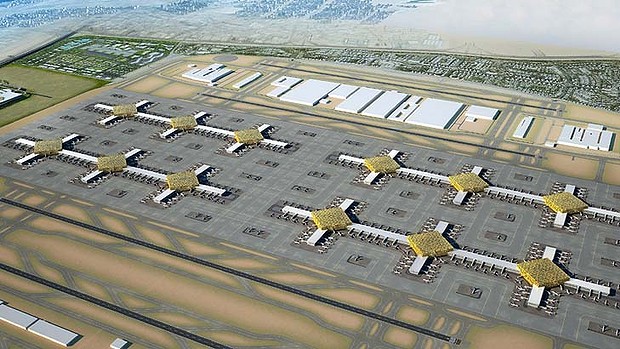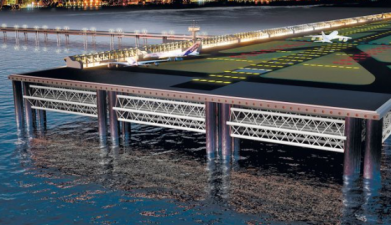 Al Maktoum International Airport at Dubai World Central (DWC) was recently approved for a $33 billion expansion making it the largest airport project on the planet – another world record for the booming emirate.
Al Maktoum International Airport at Dubai World Central (DWC) was recently approved for a $33 billion expansion making it the largest airport project on the planet – another world record for the booming emirate.
The project kicked off Monday with an endorsement from His Highness Sheikh Mohammad Bin Rashid Al Maktoum, Vice-President and Prime Minister of the UAE and Ruler of Dubai.
Construction will start by this year and complete in 2022 but unless they break ground by the end of the year, “…we probably won’t achieve the aggressive deadline we’ve set,” Paul Griffiths, Dubai Airports chief executive, told Gulf News.
Expanding a state-of-the-art airport in largely underdeveloped desert terrain – one able to accommodate new super-sized aircraft and equipped with the latest technologies for baggage handling and security – is a logical next step in the emirate’s aviation master plan.
Expansion at this scale can be an environmental shape-shifter, an incredible opportunity to emerge as a world leader in sustainable transportation. But media is stunningly silent as to the environmental impacts resulting from the physical expansion, increased air traffic, and associated bump-up to ground operations and road traffic. These have far-reaching effects that can’t be mitigated by a green building award.
Are there green aspects to the project that are hiding in the dunes? If so, it’s unthinkable that they are not being trumpeted by the airport operator, airlines, and cast of consultants involved in the project. Where are the environmental agencies? (In the US and UK, as example, planning permissions typically include obligations for developers to underwrite environmental projects in connection with base scope.)
It’s good to have the backing of the Sheikh.
In 2010, the airport opened for cargo operations with commercial passenger traffic commencing in October, quickly reaching capacity of seven million annual passengers (PAX) largely due to increased traffic from regional carriers, Gulf Air and Qatar Airways.
Dubai boasts two major airports both operated by Dubai Airports. Passenger traffic at the larger facility – Dubai International (DXB) – is expected to approach 100 million in 2020, triggering the need for rapid expansion at DWC. Expansion of the newer, smaller airport will allow for radical modification of DXB with minimal disruption to overall Dubai air traffic.
The expansion is based on a modular design and will be achieved in two phases, ultimately creating a facility capable of handling up to 120 million PAX and 100 Airbus A380 aircraft at any one time. (To put that into perspective, that’s room for Saudi Prince Alwaleed bin Talal al-Saud’s private Airbus A380 – plus those of his 99 closest friends.) Subsequent expansions will respond to future increases in aeronautical and passenger demand.
Work will take place over an area covering 56 square kilometers and will include construction of three new runways, and up to five parallel runways which will allow up to four aircraft to land simultaneously. Two satellite buildings will also be constructed specifically to cater to the Airbus A380 fleet.
Emirates, Dubai’s flagship airline, and the largest carrier in the Middle East, boasts over 50 Airbus A380s with another 140 on order. The airline may ultimately switch hubs from Dubai International to the new-large-aircraft-friendly airport, but a decision is pending. “Either Emirates will need to move as soon as the airport opens or other airlines will need to relocate,” said Dubai Airports CEO Paul Griffiths.
Griffiths continued, “Our future lies at DWC. With limited options for further growth at Dubai International, we are taking that next step to securing our future by building a brand new airport that will not only create the capacity we will need in the coming decades, but also provide state of the art facilities that revolutionize the airport experience on an unprecedented scale.”
Dubai Airports forecasts that passenger demand could exceed 190 million PAX by 2030, and climb to over 260 million by 2040 and 309 million by 2050, blowing past both London’s Heathrow and Istanbul’s Atatürk airports.
The aviation sector is projected to remain a cornerstone of Dubai’s economy, supporting more than 322,000 jobs and contributing 28% of Dubai’s GDP by 2020. If only the stats for green performance were as well-broadcast, and robust.




